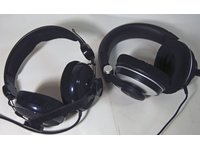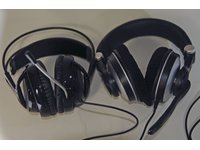On The Bench: Corsair's HS1 USB Gaming Headset
Corsair's First Headset: The HS1
Corsair isn’t the first company that jumps to mind when it comes to audio, but the Fremont, California company aims to change that with the release of its HS1 USB gaming headset.
You might think that motherboards or graphics cards would be a logical next move, given the company's forays into PC cases and power supplies, coupled with the manufacturing experience gained from its bread-and-butter memory products. But motherboards and graphics cards force tight margins and high support costs. Given VP of marketing Jim Carlton’s roots in Creative Labs and Logitech, it’s probably not a big surprise that Corsair is moving into the audio space, though. Still, there are a ton of good headsets on the market. So, Corsair decided to focus on two things: price and audio quality.
The result is a headset that won’t (pardon the pun) turn any heads for its looks, but will please your ears your wallet. The HS1 offers 50 mm drivers built into fully circumaural, close-backed cups. Completely surrounding the ear and closing the backs made the challenge of designing this headset a little easier, while simultaneously masking outside noises better than cups that partially cover the ears. The boom microphone is of the now-common noise cancelling variety, and rotates out of the way.
The inline volume control is quite large, and easy to find in the dark. The controls couldn’t be simpler: microphone mute and large, tactile buttons for increasing or decreasing volume.
Building headphones, much less a complete headset, using 50 mm drivers can result in a heavy unit with the potential to be fatiguing over long periods. The padded headrest is comfortable enough, but the cups are what set this headset apart. The ear pads are made of cloth-covered memory foam, which is easily user-replaceable. Corsair says it will be offering replacement pads directly from its Web site.
We wore the HS1 for extended listening periods (six hours in one case), and it proved to be one of the most comfortable headsets we’ve ever worn. Of the three headsets mentioned in this review, Corsair's was the only unit that didn’t actually rest on part of an ear, which made it more comfortable right out to the box.


Get Tom's Hardware's best news and in-depth reviews, straight to your inbox.
-
agnickolov No technical data provided here, so I had to look it up on Corsair's web site. The dynamic range is 20Hz-20kHz, which is a very solid showing in contrast to all the other sub-par gaming headsets reviewed here on Tom's Hardware. However, it's still no match to a professional gaming headset like the Sennheiser PC 350 (10Hz-26kHz). I couldn't find HD 580 on Sennheiser's web site (discontinued I suppose), but the updated model HD 600 has a dynamic range of 12Hz-39kHz, so it's a different ball game again. In the author's defense, it's very hard to discern audio quality differences beyond 20kHz and many humans cannot do that.Reply
I'd say for its price of $100, this headset is a great value. For comparison, the MSRP for the Sennheiser PC 350 is $250, while it can be found online starting at $125.
-
DavC agnickolovNo technical data provided here, so I had to look it up on Corsair's web site. The dynamic range is 20Hz-20kHz, which is a very solid showing in contrast to all the other sub-par gaming headsets reviewed here on Tom's Hardware. However, it's still no match to a professional gaming headset like the Sennheiser PC 350 (10Hz-26kHz). I couldn't find HD 580 on Sennheiser's web site (discontinued I suppose), but the updated model HD 600 has a dynamic range of 12Hz-39kHz, so it's a different ball game again. In the author's defense, it's very hard to discern audio quality differences beyond 20kHz and many humans cannot do that.i dont think there's hardly any people who can hear above 20kHz (or below 20Hz). i remember we tried it in a science lesson at school, out of a class of about 30, there was only me and one other person who could hear a tone upto just over 18kHz.Reply
I've always been under the impression 20Hz - 20kHz is the full range of human hearing. anything above or below that is pointless measuring, and of no use what so ever.
Anyway, this headset looks good. i've never done gaming with a proper headset before, and am rather tempted by this one. -
7amood I see no graph... just words describing what the reviewer feel.Reply
I only see general pictures of the headphones...
this is not the quality review i'm used to see from tom's...
total disappointment, but still interested in the headphone. -
nanonyous That 'easy to use' control panel is the standard C-Media control panel, which leads me to believe the audio controller employed in the headphones is a C-Media derivative, if not a C-Media chip.Reply -
precariousgray "But that capability is there, so if you’re a man who plays female characters in MMOs, you can now sound like one as well."Reply
Only good/interesting/informative part of this "review." -
ares1214 The more products corsair releases, the better if you ask me. And for those who wanted more graphs or pictures, audio quality is something very hard to do that with. Sure, he can do a dB chart, dynamic range chart, which he already said, but thats about it. This should have been a lot of opinion, and it was, which is good. Not everybody might thing they are comfortable or not. Same with audio quality. A 20Hz-20kHz is the official hearing range of humans. VERY few can hear below/above, and those who can likely cant tell the difference. It would be a waste of money to make them go any further.Reply

